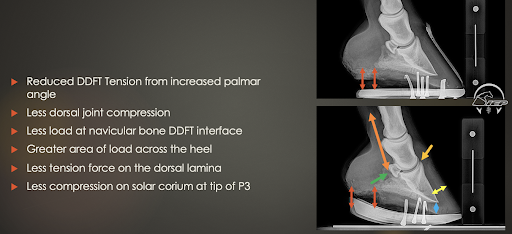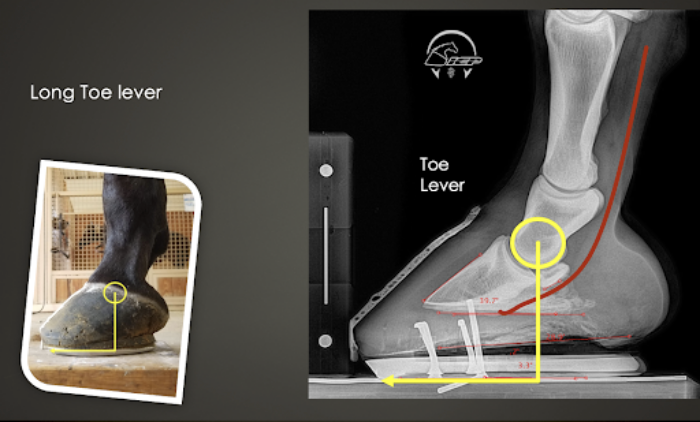Sammy Pittman has found ways to help horses lengthen their careers and stay comfortable by honoring the natural biomechanics of the horse.
The owner of Innovative Equine Podiatry and Veterinary Services has also gained a reputation for fixing the unfixable and using his outside-of-the-box approach to benefit horses all over the country. Owners take their horses to him after they’ve exhausted every option and still cannot find an answer to why their horse is lame. Western pleasure is one discipline that presents a unique challenge for both farriers and veterinarians and Pittman specializes in difficult cases with horses across the industry.
First, it is important to understand what is being asked of horses during Western pleasure events and training. According to the Quarter Horse Association’s horse judging manual, “A good Western pleasure horse has a free-flowing stride of reasonable length in keeping with his confirmation. He should cover a reasonable amount of ground with little effort. Ideally, he should have a balanced, flowing motion, while exhibiting correct gaits that are of proper cadence. The quality of the movement and the consistency of the gaits is a major consideration.”
What does this mean? According to Pittman, this means that the horse used in Western pleasure demonstrates a specific type of movement. This movement is best compared with the way that a bodybuilder performs slow, controlled curls with a heavyweight, as opposed to other events that might require quick-twitch muscles or heavy aerobic activity. This gait puts a massive amount of wear and tear on the horses’ muscles. Although breeding plays a part, the intensity of adolescent horse training programs means that horses will work very hard at a young age, and Pittman usually sees these horses between the ages of 8 and 15, when their bodies begin to break down because of inconsistencies in their shoeing programs from birth, combined with intense training programs that also start at a young age.
The Long Toe Lever
The first problem that is commonly seen in Western pleasure horses is a long toe lever. When describing a toe lever, Pittman looks at the center of rotation of the coffin joint. This is important because the deep digital flexor tendon sits underneath the joint. When the toe lever is long, it works against the tendon. The longer that it is, the more advantage that the ground has on pushing up on the coffin bone, pulling on the tendon and slapping the navicular bone.
Having a long toe lever can lead to a low palmar angle because long toes tend to load their heels more. On the flip side, a low palmar angle can also cause a long toe. A low palmar angle causes more tendon strain and problems in the back of the foot. This means that the coffin joint will have a low angle. A low coffin joint angle will cause horses to have a long toe and low heel. Without the help of X-rays, it can be difficult for farriers to map out the bone angle and design a management program for the horse.

Without the help of X-rays, it can be difficult for farriers to map out the bone angle
and design a management program for the horse. This horse has a coffin bone with
a 39.7-degree angle. This angle, along with the long toe lever, can be a major piece
of the puzzle to lameness cases.
In the example shown above, the horse has a coffin bone with only a 39.7-degree angle. This angle, along with the long toe lever, can be a major piece of the puzzle to lameness cases. The farrier had a 3-degree wedge pad on the horse at the time; however, the horse still has a negative palmar angle and a poor digital alignment. A horse with this naturally low coffin bone angle should never be in a perfect perimeter fit, traditional, normal, or full-toed type shoe, in Pittman’s opinion. If you compare most average healthy feet that have no leverage problems, the center of this coffin joint will be in the middle of the foot; the coffin bone angle will be about 50 degrees. Being in the low 40s or 30s means that the horse will require some type of specialty measures to correct the low angle and maintain soundness.
So, how do we fix this type of situation? The first step is a full rocker trim and wedge shoe with a positive pressure frog plate for additional support. This will help improve the digital alignment and reduce both leverage and workload on the deep digital flexor tendon. This shoeing will be less likely to create excessive heel load, but will still require monitoring and management. Pittman recommends learning how and when to use a rocker shoe. For more information on rocker shoes, check out “How Rocker Shoes Can Help Rehabilitate Lame Horses.”
A long toe lever can be the start of a slew of soundness problems for horses. One of these is biomechanically-induced navicular syndrome. Understanding the cause will help farriers and veterinarians prevent this condition.
Many soft tissue structures surround the navicular apparatus. Due to the load that comes down P1 and loads the back part of the foot and coffin joint, i.e. the navicular apparatus, there is a ton of soft tissue wear and tear. The impar ligament, suspensory ligament of the navicular bone, the bursa and the tendon itself all have an excessive load in situations where the heel becomes upright. Once there is enough wear on the soft tissue, bone changes begin to take place. Once the horse has reached a certain age, the bone changes will show up radiographically, but sometimes on younger horses. MRI is necessary to see the soft tissue damage before it affects the bones. Although the long toe lever sometimes starts the domino effect and is commonly found to be responsible for soundness problems in Western pleasure horses in particular, including biomechanically induced navicular syndrome, it is not alone.

Horses with an upright foot have a horn lamellar zone that is wider at the bottom,
as well as some remodeling of the tip of the coffin bone. this comes from the action
of the deep digital flexor tendon. It pulls up, compresses the apex of the bone and
pulls the horn lamellar zone apart.
Club Foot/Mule Foot
Pittman often sees a mule-footed or club-footed type of horse in his clinic. This type of foot presents the opposite problem when compared with the foot with a long toe lever. These horses with an upright foot have a horn lamellar zone that is wider at the bottom. Also, there is some remodeling of the tip of the coffin bone. This comes from the action of the deep digital flexor tendon. It pulls up, compresses the apex of the bone and pulls the horn lamellar zone apart. The common pathology that Pittman sees is that a lot of times, horses will get thin soles or pedal osteitis at the tip of the coffin bone in this situation. They will have joint compression and some coffin joint disease. The load is so tight that it pulls the coffin bone in a palmar direction and pushes the navicular bone up into the bottom part of P2, and pushes it forward. Although coffin joint injections can alleviate pain for a certain period of time, mechanical intervention can be more helpful over the long term. On some horses, cartilage erosion in that part of the joint from the interaction can be found either in dissection or MRIs. These types of cases are where actual navicular bone disease cases are found, that have an actual bone cyst as opposed to biomechanically induced navicular.
In the example of the mule-footed or club-footed upright horse, Pittman will also use a rocker shoe, but for different reasons. The problem in these cases is not leverage, but rather a deep digital flexor tension problem. A way to reduce tension, or the level of work that goes through the flexor apparatus, is possible with a rocker shoe. One complication of this type of job is that horses might have some heel soreness because of loading the heel and reducing the dorsal joint compression and navicular load. He also warns against getting the rocker too far back in these cases, because it can cause horses to stand upright on their toe and stab the toe into the ground.
Here are some other common problems that can arise if the biomechanics of the horse are ignored in either of the examples listed above.
- DDFT tendonitis.
- Navicular bursitis.
- Desmitis of the suspensory ligament of the navicular bone.
- Desmitis of the impar ligament.
- Coffin joint hyperextension.
- Heel pain.
This raises the question that you may be asking as a responsible horse owner, or equine professional — “How can I prevent these problems with my horses?”

The results of mechanical management with this mule-footed horse.
Mechanical Management
Pittman’s answer to this is also the foundation of his veterinary program. It involves utilizing mechanical management as the top priority, while using medical intervention as a complementary approach, as opposed to ignoring mechanical management and focusing on medical intervention after problems arise. The standard that he has witnessed in the industry is that veterinarians may take X-rays, or examine a horse in other ways and they simply write instructions to the farrier. The farrier is often left in the dark about the actual biomechanical findings on the horse. Pittman bridges this gap by sitting down with the farrier and the information that is gathered and explaining to them how to best help the horse based on the findings. This clear communication benefits the horse greatly because both professionals on their team are on the same page and working towards the same goals for the horse. This is important to begin from a young age because Pittman has found that the coffin bone angle can be determined in horses as young as 60 days old.
Veterinary science gives farriers the chance to see what is going on inside of the horses’ feet and legs from a young age so that they can best honor that anatomy and keep the horse comfortable for its entire career. It is important that as an owner, or as a farrier, you have a team that is dedicated to looking out for the best interest of your horse and wants to set it up for a successful, long career in Western pleasure or another discipline.
Learn More
How Rocker Shoes Can Help Rehabilitate Lame Horses: Implementing a rocker shoe can help improve horses stay comfortable on a biomechanical level.
Loading Critical to Reducing Forces and Navicular Compression: Raising the heels can help in managing many deep digital flexor tendon concerns.
Club Foot or Upright Foot? It’s All About the Angles: Proper diagnosis is important to determine a maintenance plan.
Defining and Fixing a Horse’s Club Foot: Hall of Fame farrier Simon Curtis maps how the industry can eradiate the equine club foot.







